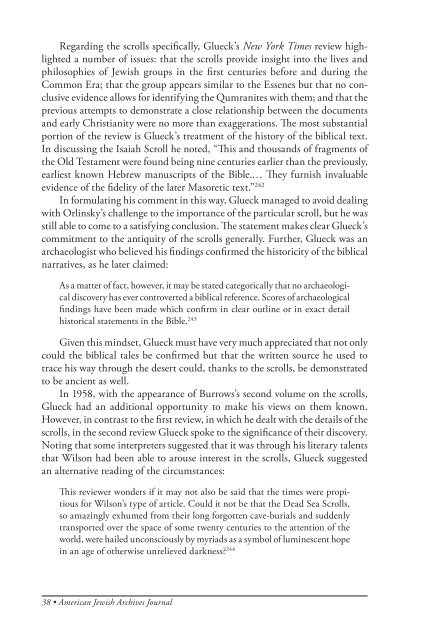The American Jewish Archives Journal, Volume LXI 2009, Number 1
The American Jewish Archives Journal, Volume LXI 2009, Number 1
The American Jewish Archives Journal, Volume LXI 2009, Number 1
You also want an ePaper? Increase the reach of your titles
YUMPU automatically turns print PDFs into web optimized ePapers that Google loves.
Regarding the scrolls specifically, Glueck’s New York Times review highlighted<br />
a number of issues: that the scrolls provide insight into the lives and<br />
philosophies of <strong>Jewish</strong> groups in the first centuries before and during the<br />
Common Era; that the group appears similar to the Essenes but that no conclusive<br />
evidence allows for identifying the Qumranites with them; and that the<br />
previous attempts to demonstrate a close relationship between the documents<br />
and early Christianity were no more than exaggerations. <strong>The</strong> most substantial<br />
portion of the review is Glueck’s treatment of the history of the biblical text.<br />
In discussing the Isaiah Scroll he noted, “This and thousands of fragments of<br />
the Old Testament were found being nine centuries earlier than the previously,<br />
earliest known Hebrew manuscripts of the Bible.… <strong>The</strong>y furnish invaluable<br />
evidence of the fidelity of the later Masoretic text.” 242<br />
In formulating his comment in this way, Glueck managed to avoid dealing<br />
with Orlinsky’s challenge to the importance of the particular scroll, but he was<br />
still able to come to a satisfying conclusion. <strong>The</strong> statement makes clear Glueck’s<br />
commitment to the antiquity of the scrolls generally. Further, Glueck was an<br />
archaeologist who believed his findings confirmed the historicity of the biblical<br />
narratives, as he later claimed:<br />
As a matter of fact, however, it may be stated categorically that no archaeological<br />
discovery has ever controverted a biblical reference. Scores of archaeological<br />
findings have been made which confirm in clear outline or in exact detail<br />
historical statements in the Bible. 243<br />
Given this mindset, Glueck must have very much appreciated that not only<br />
could the biblical tales be confirmed but that the written source he used to<br />
trace his way through the desert could, thanks to the scrolls, be demonstrated<br />
to be ancient as well.<br />
In 1958, with the appearance of Burrows’s second volume on the scrolls,<br />
Glueck had an additional opportunity to make his views on them known.<br />
However, in contrast to the first review, in which he dealt with the details of the<br />
scrolls, in the second review Glueck spoke to the significance of their discovery.<br />
Noting that some interpreters suggested that it was through his literary talents<br />
that Wilson had been able to arouse interest in the scrolls, Glueck suggested<br />
an alternative reading of the circumstances:<br />
This reviewer wonders if it may not also be said that the times were propitious<br />
for Wilson’s type of article. Could it not be that the Dead Sea Scrolls,<br />
so amazingly exhumed from their long forgotten cave-burials and suddenly<br />
transported over the space of some twenty centuries to the attention of the<br />
world, were hailed unconsciously by myriads as a symbol of luminescent hope<br />
in an age of otherwise unrelieved darkness? 244<br />
38 • <strong>American</strong> <strong>Jewish</strong> <strong>Archives</strong> <strong>Journal</strong>

















